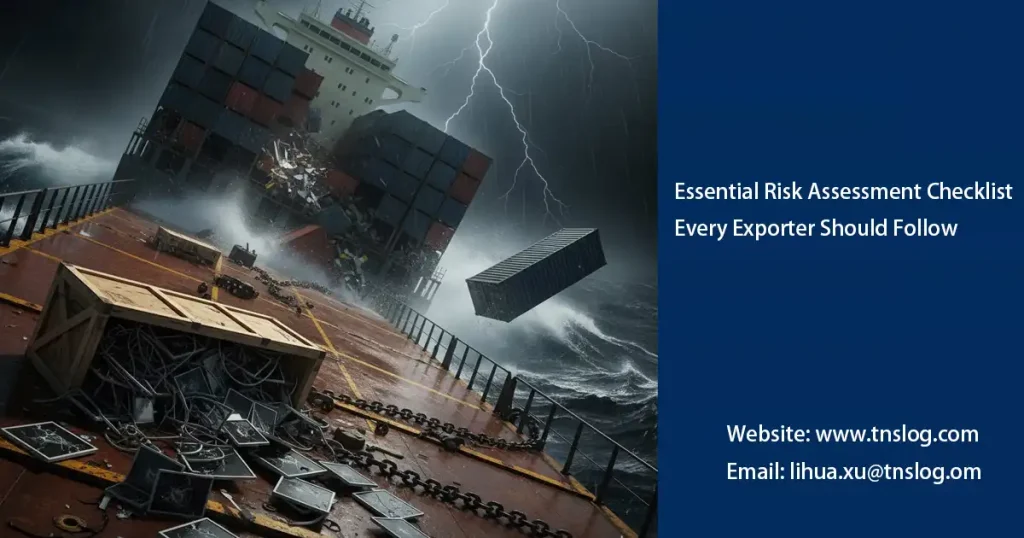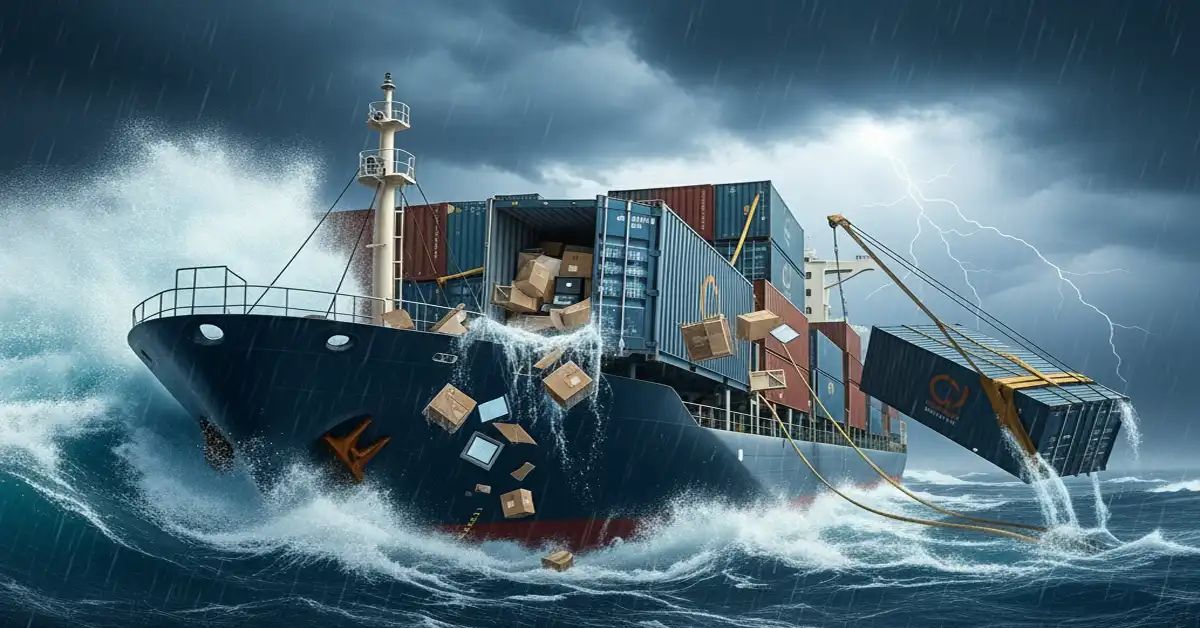Essential Risk Assessment Checklist Every Exporter Should Follow
Exporters face a narrow margin for error: one paperwork mistake, an under-insured shipment, or poor packaging can turn a profitable sale into a costly claim. This practical, operation-focused checklist helps exporters systematically assess and reduce risk before goods leave the factory gate. It’s written to answer the questions exporters actually search for — “What could go wrong?”, “How do I prove loss?”, and “How do I keep premiums manageable?” — and to give concrete actions you can apply now.

Identify and Assess Cargo Type and Value
Accurate cargo classification and true valuation are the foundation of any risk assessment. Mistakes here cascade into packaging errors, wrong insurance products, and underinsurance.
What to do
- Classify goods precisely. Record HS code, product description, hazardous components (e.g., batteries, chemicals), and whether goods are perishable, temperature-sensitive, fragile, or high-value.
- Calculate landed value. Use invoice value + freight + duties + 10–20% contingency for incidental expenses (repairs, testing, expedited shipping). This is the amount to declare to insurers.
- Segment your cargo. Separate shipments by risk class (e.g., electronics with lithium batteries vs. textile cartons) and treat each class with its specific controls.
- Identify single points of failure. For high-value lines, list where a single mishap would create the biggest loss (factory packing, terminal yarding, transshipment hub).
Evaluate Shipping Route and Destination Risks
Route risk is not only about weather — it includes port congestion, transshipment exposure, security levels, and geopolitical factors.
How to assess routes
- Map the full route. Origin yard → port of loading → transshipment hubs → port of discharge → inland leg. Note every handoff.
- Identify hot spots. Flag ports or hubs with known theft/pilferage history, frequent strikes, slow customs, or seasonal weather risk (cyclone seasons, monsoons).
- Check transit time variability. Longer or highly variable transit increases exposure and may require additional coverage (contingent delay, refrigeration failure endorsements).
- Consider modal risk differences. Road feeder services, rail, and barge legs have different loss profiles than ocean legs — ensure insurance and contracts cover each.
Review Packaging, Handling, and Storage Standard
Good packaging and handling practices prevent the majority of avoidable claims. This section turns best practices into enforceable checks.
Packaging checks
- Materials selection: Use marine-grade, moisture-resistant materials for ocean shipments (waterproof liners, coated cardboard, corrosion inhibitors). For electronics, specify ESD-safe inner materials and silica gel / humidity indicators.
- Unitization: Palletize to standard sizes; use corner boards, shrink-wrap, and steel or plastic strapping rated for load weight.
- Internal protection: Shock mounts, foam inserts or suspension crates for fragile and precision goods.
- Sealing & tamper evidence: Tamper-evident seals and serialised container seals — record numbers pre-shipment.
Handling & storage requirements
- Stuffing supervision: Require a certified supervisor at container stuffing for high-value or mixed consignments; photograph and timestamp the process.
- Stowage instructions: Provide carrier with stowage notes (e.g., “top of stack only,” “no double-stacking”) and insist on documented compliance.
- Warehouse standards: Verify humidity control, pest control, and CCTV for storage prior to shipment.
Documentation to collect
- Packing list, photos of palletization, humidity indicator card readings, seal numbers, and stuffing supervisor sign-off.
Verify Insurance Coverage and Policy Terms
Buying insurance without checking the wording is a common exporter mistake. Coverage must align with cargo class, route, and potential failure modes.
Insurance verification checklist
- Policy type: Know whether you have ICC A (All Risks), ICC B, or ICC C wording and what each excludes. For high-value or sensitive cargo ICC A is often recommended.
- Declared value: Ensure the insured sum equals your landed value (invoice + freight + duties + contingency).
- Named perils vs. All Risks: Understand if weather, theft, or delay are excluded unless specifically endorsed. See the claims process expectations to help with preparation. For practical steps when a loss occurs, consult the Step-by-Step Guide to Filing a Marine Cargo Insurance Claim
- Specific endorsements: Batteries, temperature deviation, war/political risk, or transshipment coverage — request specific wording if required.
- Deductibles & sub-limits: Check for sub-limits on theft, temperature loss, or shortage — these can materially reduce recoverable amounts.
- Notification & claims timing: Note insurer timelines for notice of loss (often within 3–7 days for visible loss) and required documents.
- Insurer reputation & claims handling: Use insurers or programs with quick surveyor access and documented claim settlement experience.
Cost-control note
Long-term or volume clients should seek program/annual policies rather than single-voyage placements to secure better terms. For actionable ideas on cost reduction without sacrificing protection, read Tips to Reduce Your Marine Cargo Insurance Premium.
Conduct a Final Pre-Shipment Risk Audit
Before dispatch, perform a rapid audit using a standardized checklist to catch last-minute vulnerabilities.
Final audit items (mandatory)
- Document integrity: Do invoice, packing list, B/L consignee, and insurance certificate match exactly? Any discrepancies will cause delays or claim disputes.
- Value confirmation: Has the declared insured value been verified and paid?
- Packing & sealing: Are pallets secured? Are seals in place and recorded? Photos taken?
- Special instructions: Are temperature loggers installed (if needed)? Has the carrier been briefed on special stowage instructions?
- Chain of custody: Is a clear chain-of-custody record maintained for any handoffs, including times, names, and signatures?
- Contingency plan: Is there a contact list (carrier rep, forwarder claims officer, insurer), and are surveyor instructions pre-arranged for quick response?
Quick pass/fail rule
Any single “fail” on declared value mismatch, missing seal numbers, or absent insurance certificate should require immediate remediation before loading.
Partner Evaluation and Compliance Checks (Optional but high-value)
Selecting the right freight forwarder, carrier, and warehousing partners reduces your exposure significantly.
What to verify with partners
- Certifications & accreditation: FIATA, ISO, or equivalent; evidence of hazardous goods handling if applicable.
- Claims experience: Ask the partner for anonymized case studies showing successful claims handling.
- Responsiveness: Define SLAs for incident reporting and escalation in the contract.
- Compliance checks: Ensure partners comply with IMDG for dangerous goods, cold chain protocols, and destination country import rules.
Practical Templates and Evidence You Must Keep
Maintain a digital folder per shipment containing:
- Commercial invoice, packing list, B/L, insurance certificate/policy excerpt.
- Pre-shipment photos (packing, pallet IDs, seal numbers).
- Certificates (MSDS, temperature calibration, ESD test where applicable).
- Data logger files and GPS tracking exports.
- Signed stuffing/warehouse supervision reports.
This documentation is what insurers and surveyors will ask for first; lacking them delays or defeats claims.
A repeatable risk assessment checklist should be embedded into pre-shipment SOPs. Doing so protects revenue, lowers the chance of rejected claims, and strengthens negotiating leverage with insurers.
Contact us today to schedule your shipment risk review and receive a tailored checklist and insurance placement recommendations that can reduce exposure and help control premiums.
You may also be interested in
Have Anything To Ask Us?
Please fill in your email in the form and we’ll get back to assist you soon!




